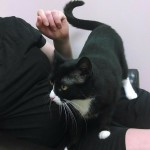Nothing is more satisfying than a purr-filled cuddle session with your favorite feline. You may wonder why cats purr, and what it means.The science behind purring has fascinated people for years, and is still being debated about today.
What it means
Most people are familiar with the theory that cats purr when they are happy. This statement is true, but purring can mean more than just contentment. Cats also purr when they are nervous or stressed. Mothers often purr to their kittens as they purr back during nursing in their early months. This is why people associate happiness and comfort with purring. However, when cats are in pain or nervous, they will purr to calm themselves down. Often cats will purr when they are being examined at the vet because they are not familiar with their surroundings and become stressed.
Science Behind Purring
Endorphins are the main scientific explanation for purring. When endorphins are released into your cat’s system, a process occurs that results in purring. It all begins in the brain. Neurological messages are sent to the laryngeal passages and diaphragm muscles. Your cat then pushes air back and forth between structures in the larynx called vocal chords. This is what causes the vibrating noise your cat makes when it purrs.
Did You Know?
Lions, tigers, jaguars, and leopards can also purr, but only while exhaling.
If you would like to schedule an appointment for your cat click here : http://northernilcatcliniccom.web.siteprotect.net/schedule-appointment/
